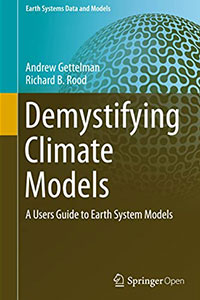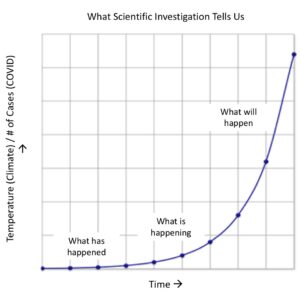Science and security
Climate scientists have a difficult time explaining to the general public why scientific investigation matters to our security. It is not surprising. Scientific subject matter is often complex and laced with arcane language. Scientific results may challenge the delicate balance between politics, economics, and power.
In recent weeks, governmental and societal responses to the COVID-19 pandemic have been “eerily similar” to what we have seen with climate change. Both crises threaten the human race on a global scale and require us to act as a collective. But that action requires good information. So how do we explain science-based information to the public when it involves complicated mathematical models and simulations? More importantly, how do we convince others that what those models say will likely happen?
Systems and schematics
 Models are, by definition, “a schematic description of a system, theory, or phenomenon that accounts for its known or inferred properties and may be used for further studies of its characteristics.” There are many levels of abstraction in that definition. Arguably, there is nothing concrete and tangible, with the exception perhaps of the model itself. We are looking at a system, we are describing the system, and that description is schematic. In the case of climate change and the COVID-19 pandemic, that schematic description is also mathematical. We are dealing in abstract symbols to represent something real.
Models are, by definition, “a schematic description of a system, theory, or phenomenon that accounts for its known or inferred properties and may be used for further studies of its characteristics.” There are many levels of abstraction in that definition. Arguably, there is nothing concrete and tangible, with the exception perhaps of the model itself. We are looking at a system, we are describing the system, and that description is schematic. In the case of climate change and the COVID-19 pandemic, that schematic description is also mathematical. We are dealing in abstract symbols to represent something real.
Educators and communicators tell us it is challenging to teach and talk about systems, i.e., interrelated and interacting actions that form a complex whole. Systems thinking is not for everyone. Neither is teaching about models and model representations of complex systems. Finally, many people react to mathematical descriptions as being so daunting as to be repugnant. (Ironically, math is the easiest and best-described part of the problem.)
Intrinsically, this is a communication problem with enormous barriers, even if the purpose is to inform those who are simply curious. When we challenge economic and social power structures, there is outright resistance to the messages.
Is “the” answer scientific literacy? Probably not. There is far more to be gained by clear communication, especially in the limited time we have to deal with climate change or COVID-19. Scientists must build public trust at various levels, delivering details and background that meet the audience’s capacity for understanding and acting on the information.
Model-based reasoning
 Both climate change and the number of COVID-19 cases have curves that look like the figure here. Time is on one axis and either temperature or number of cases is on the other. As time moves forward, we see a rise in the temperature or the number of cases. Then the curve rises faster and faster. If one plans to communicate broadly and quickly with a graphic, the complexity on this curve is at the limit of what you are allowed.
Both climate change and the number of COVID-19 cases have curves that look like the figure here. Time is on one axis and either temperature or number of cases is on the other. As time moves forward, we see a rise in the temperature or the number of cases. Then the curve rises faster and faster. If one plans to communicate broadly and quickly with a graphic, the complexity on this curve is at the limit of what you are allowed.
Also marked on the curve is
- What has happened
- What is happening
- What will happen
The future — what will happen — relies wholly on a model. That model may be highly complex, but it is a schematic description of a system that is even more complex. Uncertainty will always be there, and that uncertainty will always challenge any decision based on the model’s guidance.
What has happened is what we know. It may extend far back in time, as with climate. We don’t have the same situation with COVID-19. But in each case, what we have known is not at all like what the model says will happen. That history anchors us in skepticism. That history also provides us the opportunity to develop and evaluate the model, and to establish its reliability.
What is happening, the here and now, relies on emerging observations and simultaneous modeling. The consideration of these observations and model simulations allows researchers to further establish the model’s reliability. When errors in the model occur, and they do, researchers strive to correct and improve them. As observations emerge and the model’s reliability grows more robust, we become more confident about what the model tells us will happen.
The model also provides intervention strategies on how to mitigate rising temperatures in the atmosphere or slow the number of new coronavirus cases.
What are you saying?
Scientists may be comfortable discussing the methodology and application of models in professional circles. But when speaking with the general public, I find it is more effective to establish real-world examples in which the model has proved successful.
In the case of COVID-19, it is natural to compare this virus’ trajectory with other outbreaks that led to pandemics: A new virus emerges and a few cases appear. Suddenly the spread is growing fast enough to notice, and soon the virus is pervasive in the population. We can see the success of comparable models for other pandemics, and that influences our confidence in the present calculations. Similar strategies of evaluation of climate models are available to establish the model’s reliability, its usefulness as a decision-making tool.
Time is ticking

A globular influenza virus bumps into a respiratory cell in the nasal passages. Tiny branches reaching upward from the cell bind with proteins on the virus’s surface like a key in a lock. Next the virus will burrow inside the cell and make copies of itself. The copies will spread through the host’s system, and a flu infection happens. (U.S. Centers for Disease Control.)
In this short column, it is impossible to document all the barriers to communicating messages that come from model-based science. The ones mentioned, so far, are basic: It is difficult to talk about systems, complexity, schematic representations (models), and mathematical representation of the model.
Time is another significant barrier we face. Humans are not comfortable with a rapidly changing environment, be it climate or viral. We compare COVID-19 to “the flu,” because we have experience with influenza over many years. Right now, we are in a somewhat uneasy balance with flu — we have intervened with behavior, vaccines, and immunity development and have stopped its unbounded growth. But right now, we are in the rapid growth phase with COVID-19.
With climate, we also have experienced a tenuous balance for many years. Here too, we have entered a rapid rise in temperatures and sea levels. But we seem inclined to reject the complicated model-based science and believe we have time to adapt to the impact of a changing climate. The immediate personal consequences of COVID-19, meanwhile, do not offer that “luxury.”
Numbers game
“Exponential growth” is the final communication challenge I’ll address. A familiar example of exponential growth is compound interest. Someone pays you 10 percent interest on $100. You then have $110. If they pay you 10 percent on $110, that adds $11. Now you have $121. If this happens seven times, your initial $100 will be about $200. It has doubled.
Exponential growth is seen in the number of COVID-19 cases. As I write this, cases in the U.S. are doubling about every 60 hours (2.5 days). It is a fact that emerging observations align with the growth model, and that the model is based on our understanding of how the virus spreads. It is the convergence of this information, along with the direct, immediate, personal impact that compels us to intervene.



Eric Orts - 1988 JD
This is quite excellent and deserves a wide readership. I recommend writing another revised version as an Op-Ed for a large-circulating newspaper or news website (ie the “real news” kind).
Reply
Richard Rood
Thank you. Will consider giving it a try.
Reply
Paul E Jacobs - 1982 BS at UC Berkeley
Professor Rood,
Well presented and very timely. Would it be ok if I posted this on LinkedIn? I am a recently retired California state government environmental regulator (~38 years at CARB and Energy Commission) and my network would find this very informative. Thank you and take care.
Reply
Richard Rood
Yes, please do. Thank you.
Reply
Paul Jacobs - 1982 UC Berkeley
Thanks Dr. Rood. I just posted this on LinkedIn.
Reply
Merritt Dailey - 2014 Columbia University
I just wanted to re-iterate the challenge of communicating model-based science concisely and clearly. I taught an introductory “crash” course on the science of climate change today, and it was difficult to keep students engaged and keep the content clear and digestible. You are locked in a struggle of oversimplifying for clarity, or burying students in nuance and details. I found it very challenging to walk the line and strike a balance in my communication.
Reply